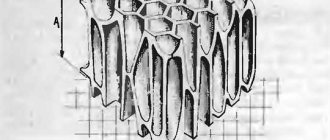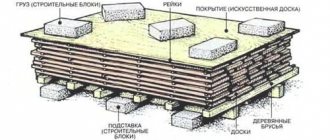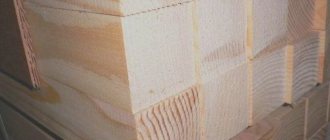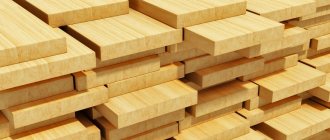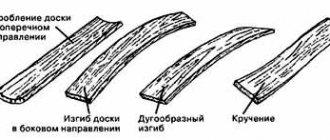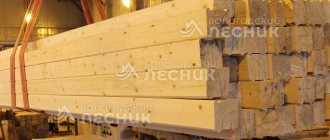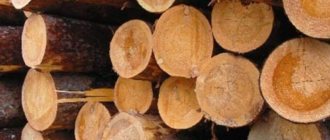Absolute humidity of wood
Absolute humidity is the ratio of the mass of moisture contained in a wood sample to the mass of absolutely dry wood of the same sample. According to GOST 17231-78, the value of absolute humidity (W) is calculated after examining (drying) the sample, according to the formula:
W = (m – m0) / m0x 100,
where (m) and (m0) are the mass of the sample before and after drying.
The concept of the value “absolute humidity”, according to GOST 17231-78, is interpreted simply as “humidity”.
Like everything “absolute”, the value of “absolute humidity” is divorced from the real world and is an extremely indigestible form for thermotechnical calculations. For example, at an absolute humidity of 25%, a kilogram of wood will contain 200 grams of water. This discrepancy in numbers confuses calculations.
The relative humidity value is more convenient and practical
Relative humidity of wood
Relative (working) humidity of wood is the ratio of the mass of moisture that a wood sample contains to its total mass. According to GOST 17231-78, the value of relative humidity (Wrel.) is calculated from the value of absolute humidity (W) of the sample, according to the formula:
Wrel.= 100W / (100+W)
or more simply,
Wrel.= mwater/ msamplesx 100
Relative humidity is a very simple and convenient form for taking into account evaporated water in wood-burning heat engineering calculations. The value of relative humidity directly indicates the quantitative water content in wood. For example, one kilogram of wood with a moisture content of 20% will contain 200 grams of water and 800 grams of dry wood matter.
For comparison, let’s put a “live” example into a table. This is a table for one and the same married sample. Let us determine and compare the values of its absolute and relative humidity:
Absolute humidity = 25%, sample weight: before drying = 1 kg (1000 g), after drying = 0.8 kg (800 g) Relative humidity = 20%, sample weight = 1 kg (1000 g) - if one kilogram of wood contains 800 grams of dry wood substance and 200 grams of water, then the value of its absolute humidity will be 25%; - if one kilogram of wood contains 800 grams of dry wood matter and 200 grams of water, then the value of its relative humidity will be 20%, Formula for determining W = (m – m0) / m0x 100CalculationW = (1000 – 800) / 800 x 100 = 25%Formula for determining Wrel.= 100W / (100+W)CalculationWrel.= 100 x 25 / (100+25) = 20%ConclusionEven though the value of absolute humidity is The primary source for determining the value of relative humidity, it is the value of relative humidity that has greater practical application. Because it (the relative humidity value) more realistically reflects the water content in the sample and does not confuse the numbers with discrepancies
Wood properties related to moisture
The main deforming properties of wood whose moisture content changes are the following:
- Shrinkage – characterized by a decrease in the volume and linear dimensions of wood. The drying process is associated only with the removal of bound water from wood; free water has no effect. When sawing logs into boards, allowances are made for shrinkage of the material.
- Warping is a change in shape of lumber that occurs during drying and improper storage. This often occurs due to different shrinkage in the transverse or longitudinal direction.
- Moisture absorption is the ability of a wood material to absorb moisture from the air. This property does not depend on the type of wood and greatly impairs its properties, reducing biostability. To protect wooden surfaces, they are coated with paints and varnishes.
- Swelling – volume and linear dimensions increase, resulting in an increase in the amount of bound water in the cells. This phenomenon occurs when logs are floated on water or wood is kept in humid air. Moreover, swelling across the fibers is observed more strongly than along them.
The property of wood to absorb liquids is used when impregnating it with antiseptics, cooking it to obtain cellulose, and rafting wood.
Wood moisture level
According to humidity, all wood is divided into three groups: wet (humidity more than 35%), semi-dry (humidity from 25 to 35%) and dry (humidity less than 25%). Initially, the moisture content of freshly cut trees is 50–60%. Then, during natural drying under a canopy in the air, the wood loses up to 20–30% of its moisture over the course of one and a half to two years and reaches a condition of conditionally equilibrium moisture content.
After this, the moisture content of the wood no longer changes significantly, and its value is ≈25%. Such wood is called air-dry. To reduce the moisture content of wood to a room-dry state (7...18%), it must be dried forcibly in drying chambers, or moved for a long time to an artificial microclimate with specified conditions (for example, moved to a room or other room).
There are the following degrees of wood moisture content:
- Floating (humidity 60% or more) This can be a tree that has been in water for a long time. For example, driftwood, or wood after sorting in a water basin, or just a well-wet (damp) log. Freshly cut (humidity 45...50%) This is wood that has retained the moisture of a growing tree. Air-dry (humidity 20...30%) This is wood that has been kept in the open air for a long time, with good ventilation. Room-dry (humidity 7 ... 18%) This is wood that has been in a living room or in another heated and ventilated room for a long time. Absolutely dry (humidity 0%) This is wood dried at a temperature of t=103±2°C to constant weight.
Equilibrium humidity
In order for lumber to be stored for a long time and not rot, it must be properly dried. To carry out the procedure, you will need an indicator of the equilibrium moisture content of the wood. It is achieved by long-term exposure of lumber to a certain external environment. When external conditions change, the equilibrium humidity also changes.
| Equilibrium moisture content of wood at different temperature and humidity conditions in winter huts | ||||||
| Month | In the external environment | In winter huts | ||||
| Air temperature, C | Air humidity, % | Equilibrium moisture content of wood, % | Air temperature, C | Air humidity, % | Equilibrium moisture content of wood, % | |
| April | 8,8 | 59 | 11,4 | 5,9 | 79 | 15,7 |
| May | 17,0 | 49 | 9,3 | 8,3 | 86 | 16,7 |
| June | 20,6 | 53 | 10,0 | 10,5 | 92 | 21,0 |
| July | 18,0 | 54 | 10,3 | 12,4 | 90 | 20,9 |
| August | 16,4 | 69 | 13,1 | 11,6 | 87 | 19,5 |
| September | 14,3 | 72 | 13,0 | 11,8 | 84 | 16,1 |
| October | 6,3 | 63 | 9,0 | 5,9 | 68 | 11,6 |
| November | -4,1 | 85 | 17,4 | -4,1 | 65 | 10,6 |
Excessive amount of moisture in the rock negatively affects the condition of the finished product and spoils the workpiece. Lumber becomes moldy when exposed to water, and fungus grows in it. Wood is porous in structure and absorbs moisture easily. It is also easy to get rid of it by decreasing or increasing in size. As a result, if the indicator is calculated incorrectly, some areas of the wooden structure may begin to bulge over time or settle. And then, under the influence of the external environment, they will be smoothed out again.
The degree of humidity in coniferous and deciduous species is different. For clear sorting of lumber, it is divided into 3 grades according to the percentage of water in the composition:
- Raw wood. Contains more than 35% moisture.
- Semi-dry. In the range from 25 to 35%.
- Dry. Less than 25%.
The following is a table of the equilibrium moisture content of wood depending on temperature and relative humidity:
| t, C | Relative humidity, % | |||||||||||||
| 35 | 40 | 45 | 50 | 55 | 60 | 65 | 70 | 75 | 80 | 85 | 90 | 95 | 98 | |
| 0 to 5 | 7,1 | 7,9 | 8,7 | 9,5 | 10,4 | 11,3 | 12,4 | 13,5 | 14,9 | 16,5 | 18,5 | 21,0 | 24,3 | 26,9 |
| 10 | 7,1 | 7,9 | 8,7 | 9,5 | 10,3 | 11,2 | 12,3 | 13,4 | 14,8 | 16,4 | 18,4 | 20,9 | 24,2 | 26,8 |
| 15 | 7,0 | 7,8 | 8,6 | 9,4 | 10,2 | 11,1 | 12,1 | 13,3 | 14,6 | 16,2 | 18,2 | 20,7 | 24,1 | 26,8 |
| 20 | 6,9 | 7,7 | 8,5 | 9,2 | 10,1 | 11,0 | 12,0 | 13,1 | 14,4 | 16 | 17,9 | 20,5 | 23,9 | 26 |
| 25 | 6,8 | 7,6 | 8,3 | 9,1 | 9,9 | 10,8 | 11,7 | 12,9 | 14,2 | 15,7 | 17,7 | 20,2 | 23,6 | 26,3 |
| 32 | 6,7 | 7,4 | 8,1 | 8,9 | 9,7 | 10,5 | 11,5 | 12,6 | 13,6 | 15,1 | 17,0 | 19,5 | 22,9 | 25,6 |
| 40 | 6,5 | 7,2 | 7,9 | 8,7 | 9,5 | 10,3 | 11,2 | 12,3 | 13,6 | 15,1 | 17,0 | 19,5 | 22,9 | 25,6 |
| 45 | 6,3 | 7,0 | 7,7 | 8,4 | 9,2 | 10,0 | 11,0 | 12 | 13,2 | 14,7 | 16,6 | 19,1 | 22,4 | 24,7 |
| 50 | 6,1 | 6,8 | 7,5 | 8,2 | 8,9 | 9,7 | 10,6 | 11,7 | 12,9 | 14,4 | 16,2 | 18,6 | 22,0 | 24,7 |
| 55 | 5,9 | 6,6 | 7,2 | 7,9 | 8,7 | 9,4 | 10,3 | 11,3 | 12,5 | 14,0 | 15,8 | 18,2 | 21,5 | 24,2 |
| 60 | 5,7 | 6,3 | 7,0 | 7,7 | 8,4 | 9,1 | 10,0 | 11,0 | 12,1 | 13,6 | 15,3 | 17,7 | 21,0 | 23,7 |
With natural drying, the figure decreases to 30%. At the same time, the dimensions and weight of the material change. To speed up the process, technologies are used that allow it to be reduced to 7-18% in a short period.
Calorific value of wet wood
The calorific value of wood is directly dependent on its moisture content.
The moisture content of firewood is a determining indicator of its quality. That dry wood burns better than wet wood is known to many, if not everyone. And everyone knows that wet firewood can always be dried, and dry firewood, on the contrary, can be wetted.
Accordingly, the quality of the fuel will change – improve or deteriorate. But is this really important for modern heating equipment? For example, wood-burning pyrolysis boilers allow you to burn wood with a humidity of up to 50%, and even up to 70%!
The table shows generalized indicators of the calorific value of wood for each degree of its moisture content.
Wood humidity (%) Mass working calorific value, kcal/kg Degree of humidity 04400 Absolutely dry wood 7…183980-3750 Room-dry wood25…303630-3120 Air-dry wood33…502870-1860 Freshly cut wood50…701800 and less Driftwood 70 and more Practically does not burn Driftwood
The table shows that the lower the moisture content of the wood, the higher its calorific value. For example, air-dried wood has a working calorific value almost twice as high as freshly cut wood, not to mention wet wood.
Wood with a humidity of 70% or higher practically does not burn. The ideal option for wood heating is to use firewood at a room-dry humidity level. Such firewood provides the maximum amount of heat.
But, since drying firewood to such a state is associated with additional energy costs, the most optimal option for heating would be to use air-dried wood. Bringing firewood to an air-dry state is relatively easy. To do this, it is enough to prepare them for future use and store them in a dry, ventilated area.
Finally, I would like to note that the moisture contained in firewood not only worsens its calorific value. Increased moisture content in fuel negatively affects the combustion process itself. Excess water vapor serves as the basis for creating an aggressive environment, which causes premature wear of the heating unit and chimneys.
Manufacturers of modern heating equipment recommend using air-dry wood as fuel, with a humidity of no more than 30-35%
Wood moisture content | Drovana tehnopost.kiev.ua
When wood moisture content is less than 30%, putrefactive fungal processes in it stop and such wood is considered suitable for long-term storage
Alternative Heating: woodwoodwoodcalorific valueheatheatingwood
Wherever wood raw materials are intended to be used - in construction, in the manufacture of furniture or carpentry blanks - its moisture content will be the main indicator of the quality and durability of the finished product. Wood has the natural property of hygroscopicity, that is, the ability to absorb moisture well and release it just as quickly when the temperature and humidity of the environment changes. As a result of these processes, a significant increase or decrease in the volumetric size of the material occurs in various directions, leading to complete unsuitability of the structure or object. In order to understand how to properly dry wood, you need to know some rules that allow you to carry out this process professionally, and be able to determine the moisture content in wood.
Scheme for drying wood under atmospheric conditions.
References
- ^ a b
Sadakam, Samy Grain Drying Tools: Equilibrium Moisture Content Tables and Psychrometric Charts. Univ. Arkansas FSA1074 - ^ a b
FAO. 2011. Rural buildings in the tropics. Design and development. Chapter 16: Drying, processing and storage of grain crops. Rome. https://www.fao.org/docrep/015/i2433e/i2433e10.pdf - What is equilibrium moisture content? https://www.wagnermeters.com/wood-moisture-meter/moisture-content-and-equilibrium-determined-by-relative-humidity/
- Hailwood, A.J.; S. Gorrobin (1946). "Water absorption by polymers: analysis based on a simple model". Per.
Faraday Soc .
42B
: 84–102. - Rasmussen, E. F. (1988). Forest Products Laboratory, USDA. (ed.). Dry Oven Operator's Manual
. Hardwood Research Council. - Eleoterio, Jackson Roberto; Clovis Roberto Haselein; Nestor Pedro Giacomini. “A program for estimating the equilibrium moisture content of wood” (PDF). Ciência Florestal
.
8
(1): 13–22. ISSN 0103-9954. Retrieved 2008-11-14. - Leivo, Virpi and Rantala, Jucca. (2003). Behavior of moisture in floors on the ground
- Experimental study on the equilibrium moisture content of soil plasters with natural reinforcing fibers for straw bale buildings Taha Ashur, Heiko Georg, Wei Wu
Wood moisture determination
In the absence of a special device - an electric moisture meter - the moisture content of wood is determined using a fairly simple method. A small piece is separated from the material and weighed.
Then it is kept in a dryer at a temperature of about 100°C and weighed again. The difference between these indicators is the percentage of water to the sample. When performing any technological operations in relation to wood, it must have a moisture content suitable for work.
Table for determining wood moisture content.
If this indicator is high, the probability of rapid failure of the future product is very high.
Fungal infections of the material, its rotting and deformation may occur during various climatic changes. Raw wood does not adhere well to gluing, and due to subsequent drying it can warp, become cracked and form cracks. All these troubles can be avoided if you learn how to dry wood, then competent drying of the raw materials will be carried out in compliance with all the technologies of this process.
All wood species can be divided into three groups according to their properties to change size when drying: weakly, moderately and strongly shrinking.
Larch and spruce practically do not change when dried, pine, aspen, willow and poplar lose moderate volume.
The wood of oak, elm, maple and beech belongs to the latter category, to which linden and alder also belong. The fastest evaporation of moisture occurs from the top layers and ends of the board. When drying raw wood, moisture simultaneously leaves the surface through the pores, and its place is taken by wood sap rising from the core through the capillaries.
Scheme of drying wood in a chamber.
The humidity of wooden products that will subsequently be used outdoors should be in the range of 12-18%, and for indoor spaces with a comfortable temperature this figure drops to 8-10%. Therefore, wood that will be used in a heated room must be dried in two stages: first in natural conditions, and then at room temperature.
Drying wood under the influence of the atmosphere takes quite a long time. This period depends on the type of wood, its thickness and time of year. The use of this method can lead to the loss of up to 75% of moisture by the material, but coniferous and soft hardwoods usually take about 2 years to dry, while hardwoods may require a longer period.
To dry wood in the open air, a flooring of poles is first made, on which the workpieces are laid in stacks, maintaining a small distance between them, and the rows are secured with driven pegs. The top layer is given a slight slope to allow rainwater to roll off, and is carefully covered with boards.
Round logs do not need to be freed from bark before drying so that they do not crack; for the same purpose, their ends can be treated with a solution of lime or table salt, which will additionally serve as protection against possible rotting. Lumber is dried in the same way, but it must first be sorted and stacked according to the principle of uniformity, that is, the thickness of the boards and the type of tree. During the drying process, valuable wood is processed not only from the ends, but also from the sides, and for this purpose you can additionally use garden pitch or PVA glue.
Natural humidity
The indicator is used to determine the amount of water inside the trunk immediately after cutting or during growth. It determines the quality of drying of wood materials. The natural moisture content of wood is considered the initial value, on the basis of which calculations for drying the material begin. If the indicator is determined incorrectly, there is a risk of under- or over-drying the lumber.
What percentage of water is contained in the trunk is determined by the following factors:
- wood structure;
- porosity;
- environment.
The natural moisture content of wood ranges from 30 to 80% and varies depending on the type of material. They are used as a starting point before determining the optimal drying mode to achieve the desired quality of the dry workpiece.
| Breed | Humidity, % | ||
| Cores | Sapwood | Average | |
| Birch | — | 70-90 | 78 |
| Oak | 50-80 | 70-80 | 70 |
| Spruce | 30-40 | 100-120 | 91 |
| Larch | 30-40 | 100-120 | 82 |
| Aspen | — | 80-100 | 90 |
| Pine | 30-40 | 100-120 | 88 |
| Ash | 35-40 | 35-40 | 38 |
| Fir | — | — | 101 |
| Cedar | — | — | 92 |
Deciduous wood has a lower natural moisture content than coniferous wood. This is due to the structure of wood. Spruce contains up to 90% moisture, fir contains up to 92%. For comparison, ash wood contains only 36%. In addition, the percentage of water in the material is influenced by the state of the environment. In winter, plants go into “dormant mode” and practically do not consume nutrients from the ground. Therefore, humidity in summer is much higher than in winter. Also, freshly cut wood has a much higher moisture percentage than older wood.
The task of those involved in lumber processing is to reduce moisture content to the lowest possible percentage. This is done so that the workpieces acquire the necessary hardness and strength. The wear and tear of products whose material has successfully undergone the drying process is significantly lower.
Humidity also affects the size of the workpieces. The more the material dries out, the smaller in size it becomes. Proper drying should be organized in such a way that moisture evaporates evenly. Then the weight and size of the workpiece will be standard, and the material itself will acquire the necessary properties. The latest methods of drying wood reduce the percentage of humidity to 6. This indicator also depends on the species, structure of the tree, and time of year.
Heavily dried wood is not used for construction, as it can crack. The amount of water in the material for these purposes is reduced in the following ways:
- Self-drying. A ready-made cut of natural moisture is purchased and laid out in stacks on the site. Gaps are made between the rows of boards using bars so that air can circulate freely. The supports must be placed at least 1.5 meters apart from each other, and the material will not bend. To prevent rain or other precipitation from spoiling the wood, the structure is covered with film or roofing felt on top. Natural drying is best done in the warm season. Materials are placed in the shade, under a canopy. Thin-width boards will dry out faster than thick ones. The structure is installed on pads made of pine branches or protective material.
- Purchase of finished material. In this case, the seller has already prepared the boards and dried them naturally on his own.
- If it is necessary to reduce the amount of moisture to 15% or lower, then chamber drying is used indoors. Such materials will be more expensive, since processing will require a large waste of resources. And it is better not to use such wood for construction, it can crack.
The ideal use of dry wood is furniture and interior items.
Drying wood indoors
Wood should be dried indoors as far as possible from dirty and wet surfaces, such as dirt floors or concrete structures. It should be remembered that the tree will take on the parameters of the surrounding environment, so the room should be dry and with an optimal air temperature of 15°C.
In private houses, well-ventilated attics are considered the best places for drying, and in apartments you can use mezzanines. If there is an urgent need, you can equip one of the rooms with air heaters, placing them along the walls, and constantly adjust the temperature for faster drying of the material. If you plan to make furniture or carpentry, you should not cut out the blanks before drying the wood - their size and shape can change significantly after drying.
Wherever wood raw materials are intended to be used - in construction, in the manufacture of furniture or carpentry blanks - its moisture content will be the main indicator of the quality and durability of the finished product. Wood has the natural property of hygroscopicity, that is, the ability to absorb moisture well and release it just as quickly when the temperature and humidity of the environment changes. As a result of these processes, a significant increase or decrease in the volumetric size of the material occurs in various directions, leading to complete unsuitability of the structure or object. In order to understand how to properly dry wood, you need to know some rules that allow you to carry out this process professionally, and be able to determine the moisture content in wood.
Scheme for drying wood under atmospheric conditions.
What is the standard humidity?
To use lumber in construction, it is necessary to sort it according to the degree of moisture. The standard wood moisture content is taken to be approximately 15% and is considered a constant indicator for any type of wood, which all manufacturers of wood products strive for. In this condition, the material is perfectly stored and used for construction and finishing work. The concepts of equilibrium and standard moisture content are familiar to any specialist working in the production of lumber.
Insufficiently dried wood is a real environment for the formation of mold and fungal growth, which leads to its destruction. Modern drying equipment allows you to achieve a humidity level of 6%. In this case, the material will be even more resistant to rotting, resistant to deformation and durable.
Wood moisture determination
In the absence of a special device - an electric moisture meter - the moisture content of wood is determined using a fairly simple method. A small piece is separated from the material and weighed.
Then it is kept in a dryer at a temperature of about 100°C and weighed again. The difference between these indicators is the percentage of water to the sample. When performing any technological operations in relation to wood, it must have a moisture content suitable for work.
Table for determining wood moisture content.
If this indicator is high, the probability of rapid failure of the future product is very high.
Fungal infections of the material, its rotting and deformation may occur during various climatic changes. Raw wood does not adhere well to gluing, and due to subsequent drying it can warp, become cracked and form cracks. All these troubles can be avoided if you learn how to dry wood, then competent drying of the raw materials will be carried out in compliance with all the technologies of this process.
How to dry wood for different operating conditions
All wood species can be divided into three groups according to their properties to change size when drying: weakly, moderately and strongly shrinking.
Larch and spruce practically do not change when dried, pine, aspen, willow and poplar lose moderate volume.
The wood of oak, elm, maple and beech belongs to the latter category, to which linden and alder also belong. The fastest evaporation of moisture occurs from the top layers and ends of the board. When drying raw wood, moisture simultaneously leaves the surface through the pores, and its place is taken by wood sap rising from the core through the capillaries.
Scheme of drying wood in a chamber.
The humidity of wooden products that will subsequently be used outdoors should be in the range of 12-18%, and for indoor spaces with a comfortable temperature this figure drops to 8-10%. Therefore, wood that will be used in a heated room must be dried in two stages: first in natural conditions, and then at room temperature.
Drying wood under the influence of the atmosphere takes quite a long time. This period depends on the type of wood, its thickness and time of year. The use of this method can lead to the loss of up to 75% of moisture by the material, but coniferous and soft hardwoods usually take about 2 years to dry, while hardwoods may require a longer period.
To dry wood in the open air, a flooring of poles is first made, on which the workpieces are laid in stacks, maintaining a small distance between them, and the rows are secured with driven pegs. The top layer is given a slight slope to allow rainwater to roll off, and is carefully covered with boards.
Round logs do not need to be freed from bark before drying so that they do not crack; for the same purpose, their ends can be treated with a solution of lime or table salt, which will additionally serve as protection against possible rotting. Lumber is dried in the same way, but it must first be sorted and stacked according to the principle of uniformity, that is, the thickness of the boards and the type of tree. During the drying process, valuable wood is processed not only from the ends, but also from the sides, and for this purpose you can additionally use garden pitch or PVA glue.
What is natural humidity?
Wood is a living material that constantly grows and breathes. Water is necessary for its life. Its content depends on the species, weather conditions and location of the tree. Immediately after cutting or sawing a log, the material has moisture, which is called natural. There are no exact standards for this value. It varies between 27–81%. Wood with natural moisture often becomes infected with fungi and bacteria and rots. It is not recommended to transport logs over long distances immediately after felling; after a few days they become unusable.
Material with natural moisture is used only for the construction of low-critical structures. Before long-term transportation and subsequent use of wood, felled logs are subjected to atmospheric or forced drying. Only after this procedure can it be safely used for the manufacture of various structures.
Drying wood indoors
Wood should be dried indoors as far as possible from dirty and wet surfaces, such as dirt floors or concrete structures. It should be remembered that the tree will take on the parameters of the surrounding environment, so the room should be dry and with an optimal air temperature of 15°C.
In private houses, well-ventilated attics are considered the best places for drying, and in apartments you can use mezzanines. If there is an urgent need, you can equip one of the rooms with air heaters, placing them along the walls, and constantly adjust the temperature for faster drying of the material. If you plan to make furniture or carpentry, you should not cut out the blanks before drying the wood - their size and shape can change significantly after drying.
1Nadyrova A.R. 1Velichkin P.S. 1Stepanova O.A. 11State University named after Shakarima
1. Handbook on wood drying / E.S. Bogdanov, V.A. Kozlov, V.B. Kuntysh, V.I. Melekhov; edited by
E.S. Bogdanov. – M.: Lesn. Industry, 1990.
– 304 p.2. Rasev A.I. Drying wood: A tutorial. – M.: MGUL, 2005. – 224 p.
Wood is a valuable material that is used in almost all industries. And even taking into account the fact that many wood substitutes have appeared recently, it still does not lose its leadership.
One of the most energy-intensive and complex processes in wood processing technology is the drying process. Wood is dried after sawmilling before wood processing in order to protect it from damage by wood-staining and wood-decaying fungi during its further storage and transportation. Drying prevents wood from changing shape and size during the manufacturing and use of products made from it, improves the quality of wood finishing and gluing.
The humidity to which wood is dried depends on the scope of its further use. The whole point is to bring the moisture content of the board to the same value that a product made from this board would reach over time during operation under these conditions. This humidity value is called “equilibrium humidity”; it depends on the humidity and temperature of the surrounding air.
To quantitatively characterize the water content in wood, an indicator is used - humidity. Wood moisture content W is the ratio of the mass of water to the mass of dry wood, expressed as a percentage:
, (1)
where M is the initial mass of the wood sample, g; Mo – mass of absolutely dry wood sample, g.
The elemental chemical composition of absolutely dry wood of all species is almost the same:
– carbon from 49 to 50%;
– oxygen from 42 to 44%;
– hydrogen from 6 to 7%;
– nitrogen from 0.1 to 0.7%;
– inorganic part from 0.1 to 2% (ash consisting of oxides of potassium, calcium, sodium, magnesium, silicon, etc.).
Absolutely dry wood contains (39÷58)% cellulose, (17÷34)% lignin, (15÷38)% hemicellulose and up to several percent waxes, resins, tannins, fats, essential oils.
In practice, wood is classified according to the degree of moisture:
– wet, W > 100%, kept in water for a long time;
– freshly cut, W = (50÷100)%, retaining the moisture content of the growing tree;
– air-dry, W = (15÷20)%, kept in the open air;
– room-dry, W = (8÷12)%, kept in a heated room for a long time;
– absolutely dry, W = 0, dried at temperature t=(103±2) °C.
Wood drying is the process of removing moisture from wood to a certain percentage of humidity. Drying wood is a very complex process, the nature of which is determined by the simultaneous occurrence of a number of physical phenomena, including:
– heat exchange, i.e. transfer of heat to the material from a drying agent or source of thermal energy;
– thermal conductivity, i.e. movement of heat within the material;
– moisture transfer, i.e. evaporation of moisture from the surface of the material into the environment;
– moisture transfer, i.e. movement of moisture inside the material [1, 2].
The work was carried out according to the following scheme:
– analysis of the state of the wood drying process;
– selection of the research object (pine samples with a thickness of 20, 30, 40, 50 mm);
– selection of drying mode;
– determination of the dependence of humidity on sample thickness.
Research was carried out for forced drying; under such conditions, wood is obtained with preservation of bending, tensile and compressive strength, but with a decrease in chipping and splitting strength by (15÷20)% and with possible darkening of the wood.
Wood moisture content was determined by the direct drying method.
Based on the results of the study, a graph was constructed (figure).
Rice. 1. Change in wood moisture content depending on the thickness of the sample
As a result of mathematical processing, equations were obtained describing the dependence of humidity W, %, on sample thickness d, mm, for various treatment durations (table).
Dependence of humidity on sample thickness
Treatment duration τ, hour Equation 10 20 30 40 50
Free and bound moisture
When a tree is cut down and lies in a warehouse, moisture is distributed evenly along the trunk. A fairly long period of time must pass before this happens. Immediately after cutting, the humidity is increased, reaching an average of 60%. The moisture inside the trunk is divided into:
- hygroscopic (free), which is retained in the fibers;
- capillary (connected), contained in plant cells.
During the drying process, only free moisture comes out of the trunk. The capillary remains. It is only about 23% in wood. If the lumber was cut down recently, the moisture will be distributed unevenly along the length of the trunk. The highest percentage is observed in the butt part, the closer to the top, the lower the percentage becomes. There is also a dependence of the amount of moisture in wood in some species on proximity to the core. In some it increases as it approaches the core, in others, on the contrary, it decreases.
Table of lumber moisture indicators:
| Wood type | Humidity indicator, % | A comment |
| Wet | Above 100 | Purchased if the material will lie in water for a long time. |
| Freshly cut | 50-100 | The tree was recently felled |
| Air dry | 15-20 | Characteristic of material that has been stored in air for a long time. |
| Chamber drying | 8-12 | Lumber is kept in a heated room for a long time |
| Absolutely dry | 0 | The wood is dried in a special machine |
When water is distributed evenly throughout the entire structure of the wood and does not exceed 15%, this is called standard humidity. In this state, the workpiece can be used for processing and preparation for work (finishing, construction). The material is well stored, but is susceptible to weather conditions; if precipitation occurs, it can get wet and the moisture content will change.
To produce quality wood, it is necessary to use both concepts (standard and equilibrium moisture content). You must understand that when using the finished product outdoors, under the influence of different temperature conditions, its properties may change. Therefore, the product must be protected with impregnation.
Bibliographic link
Nadyrova A.R., Velichkin P.S., Stepanova O.A. CHANGE IN WOOD HUMIDITY DURING THE DRYING PROCESS // International Student Scientific Bulletin. – 2015. – No. 3-1.;URL: https://www.eduherald.ru/ru/article/view?id=12031 (date of access: 09/25/2018).
Sources:
- tehnopost.kiev.ua
- 1poderevu.ru
- dekormyhome.ru
- www.eduherald.ru
There are no similar posts, but there are more interesting ones.
